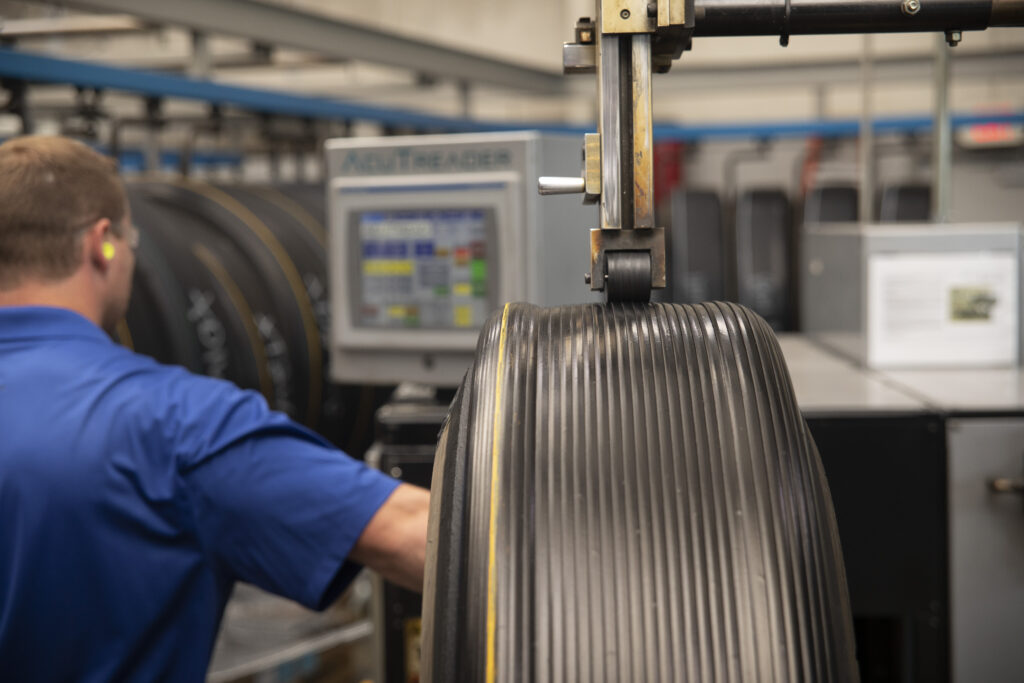
Looking to switch your fleet to remanufactured tires? Here’s what to consider when choosing a retread supplier.
Different applications will require different treads and will influence your choice of a retread supplier based on their product availability.
Remanufactured tires can be used for applications ranging from trucking to aviation. These uses will determine the characteristics you want to see in a high-quality retread.
For example, an off-road application requires that your tire have a self-cleaning tread design, cut resistance, and aggressive traction for performance both on and off the road. Long-haul, regional, short-haul, and P&D applications require a tread that is built to decrease irregular wear and increase your mileage.
Failure to equip your commercial vehicles with the right tires will lead to subpar performance. You should consult tire professionals when it comes to the remanufactured models you should use for your application to yield the best results.
View the AcuTread Product Line.

Becoming familiar with the process used by a potential retread partner will help you learn what the retread process involves and give you confidence in the final product for your fleet.
When evaluating a remanufacturing process, consider:
1. The method. Mold cure and precure treading are the two most common methods for retreading. Wonderland Tire outlines the difference between the two, most notably that the mold cure process, like our own, is much closer to how a new tire is manufactured.
2. The final product. Your remanufactured tires should be comparable to new tires. Does the manufacturer’s process yield a tire that’s perfectly balanced, with a high-quality tread pattern and no product defects?
3. Safety. Do the retread facility, its process, and its products meet tire industry safety standards?
4. Quality. Quality control is crucial to meeting and maintaining these tire industry standards. Rigorous product inspections and automated technology are two indicators that quality is upheld throughout the process.
5. Equipment used. Does the remanufacturing facility use modern equipment? Reliability is key when it comes to retreading. Top-of-the-line retreading equipment should be able to support up to 150 tires per shift without lacking in consistency and uniformity.
6. Your fleet’s needs. Does the manufacturer’s process yield a tire that meets the needs of your fleet such as traction, extended mileage, long tread life, etc.?
You can learn about each retread process by requesting plant tours and getting an in-depth look at each step of manufacturing.
Learning more about the product can show you how it is designed for the qualities that you value and that your fleet needs, such as:
1.Tread design. The types of vehicles in your fleet and your driving conditions will determine the types of tires you need. Does your retread provider manufacture models that suit your needs?
2. Balance. A premium remanufactured tire will be perfectly balanced, giving your tires a longer lifespan and keeping them free from irregular wear.
3. Premium casings. Ensure that the final product was retreaded on a good quality original tire casing. This will protect your investment by keeping your retreaded tires on the road longer, performing better.
4. Quality and durability. A premium remanufactured tire should result in even loading, a smooth ride, even wear, lower cost per mile, and improved fuel efficiency.
This can be done by getting a look at the products up close and personal to determine how the retreads actually perform. Request a plant tour.
Remember to be careful when assessing retread suppliers because not all retreads are created equal. Just like poorly manufactured tires, poorly retreaded tires have a higher likelihood of failing. That’s why we developed the AcuTread® process to remanufacture tires that are built expertly for safety, uniformity, reduced heat buildup, and longer tread life. Our streamlined technology and safety benefits include:
☑ Matched tire diameters. The AcuTread® segmented molds produce a fixed diameter every time—just like new tires. Each tire—regardless of brand—is within 1/32” in diameter. This important feature promotes even distribution of load, extending mileage and reducing heat build-up.
☑ Superior adhesion values. Each AcuTread® tire is cured with direct physical pressure resulting in very high adhesion values. AcuTread® products can withstand severe twisting and turning and higher running temperatures—just like new tires. This puts the AcuTread® process at an advantage over precure retreading.
☑ Contoured tread. The technology of the AcuTread® process ensures that every casing is prepared to an exact width and contour each time. Proper buffed casing dimensions reduce casing fatigue, shoulder separations, and tread edge lifts while also promoting even wear for extended mileage.
☑ Splice-free. Using a computerized rubber extruder, specialized rubber compounds are applied to the casing in one continuous strip, eliminating the need for a splice. Alternative precure retreading processes apply fully cured tread to casings and splice it together where the ends meet. The splice can cause a weak point and ride disturbance from an out-of-balance condition.
☑ Full-depth siping. Siping assists in dispersing heat from the tread. This “new tire” feature reduces casing fatigue and stress due to excessive heat build-up in the tread. Lower tread temperature is a key factor in extended wear and fuel economy.

There are many myths and misconceptions surrounding retreads.
Doing informed research, touring retread facilities, and seeing the products and process in action will allow you to determine how remanufactured tires perform in actuality. Visit any of our manufacturing plants for a full tour of how our tires are made!
Wonderland Tire, a co-developer of the AcuTread® process, outlines the benefits of retreading and why state-of-the-art retreading processes produce tires that are just as safe, if not safer, than new tires.
Not only are remanufactured tires safe, but smart for your fleet.
Ready to see retreads in action, saving you money and keeping your fleet on the road reliably? Partner with a retread dealer that can meet the needs of your fleet with custom retread programs.
A qualified dealer can provide guidance on which products are best suited for your fleet based on your routes, terrain, etc.
Contact us for more information about our products, remanufacturing process, facilities, or solutions for your fleet.
Website by Northbound Studio